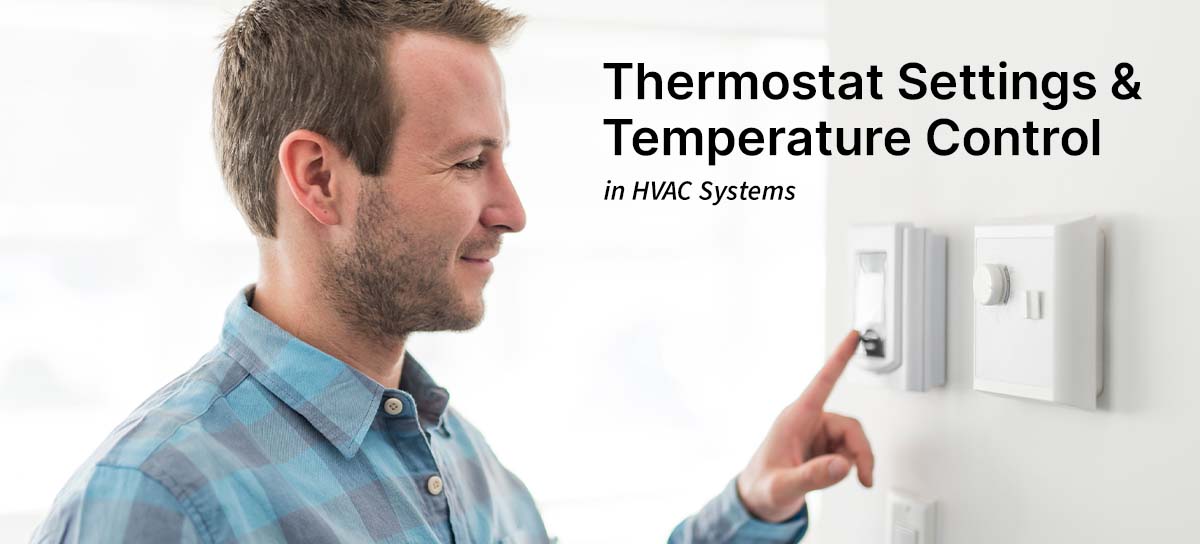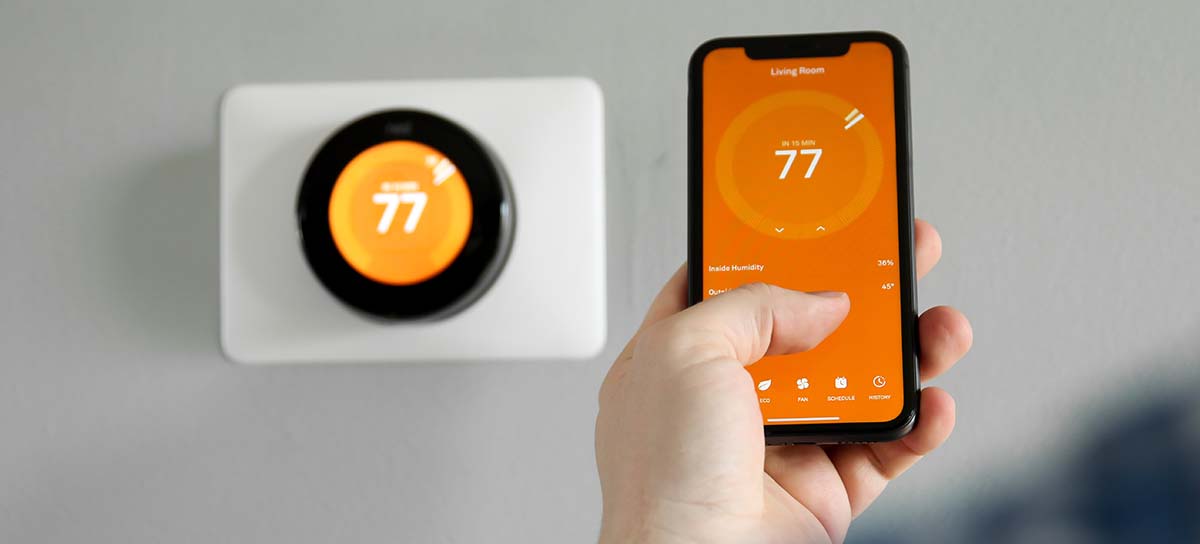
It’s that time of the year again, when everyone in your home can’t agree on what temperature to set the thermostat to!
While it’s fun to bicker over the thermostat controls, it’s actually a really important component of maintaining a comfortable indoor temperature.
Thermostat settings and temperature control in HVAC (Heating, Ventilation, and Air Conditioning) systems create a comfortable and efficient indoor environment.
Your thermostat is the control center of your HVAC system, responsible for regulating the temperature of your home. Whether you're cooling down during sweltering summer months or warming up on chilly winter nights, your thermostat settings determine how effectively your HVAC system responds to your comfort needs.
Proper thermostat settings are essential for year-round comfort, creating a cozy atmosphere that enhances contentment and productivity. Optimizing your thermostat for energy efficiency not only conserves resources but also leads to significant cost savings.
In this blog post, we'll look at the essential aspects of thermostat management and how it directly influences your comfort and energy bills.
If you’re having issues with your thermostat, give us a call! We are here to support you and help you figure out how to set up or maintain your thermostat or any other HVAC equipment giving you trouble. Our highly skilled team is one phone call or email away, so don’t be afraid to reach out for any of your HVAC needs.
Understanding Your Thermostat
Types of Thermostats
- Manual Thermostats: These are traditional, non-digital thermostats with a simple dial or slider for temperature adjustment. They require manual changes and do not have programming capabilities.
- Programmable Thermostats: Programmable thermostats allow you to set schedules for temperature changes throughout the day and week. They are more advanced than manual thermostats and can help automate temperature adjustments.
- Smart Thermostats: Smart thermostats are the latest innovation in thermostat technology. They are connected to your Wi-Fi network and can be controlled remotely via a smartphone app or voice commands. Smart thermostats often have learning capabilities and can adapt to your preferences over time.
Basic Components and Features
- Temperature Display: All thermostats have a display that shows the current temperature setting. Digital thermostats provide precise temperature readings, while manual thermostats typically have a temperature range scale.
- Setpoint Controls: Thermostats allow you to set the desired temperature for your space. With manual thermostats, you turn a dial or slide a lever to the desired position, while programmable and smart thermostats offer digital input.
- Mode Selection: Most thermostats have different modes, such as heating, cooling, and fan-only modes, to control various aspects of your HVAC system.
- Programming Interface: Programmable thermostats have programming interfaces that let you set schedules for different times of the day and week. You can program temperature setbacks during times when heating or cooling is not needed.
- Touchscreen and Controls: Smart thermostats often feature touchscreen displays for easy navigation. They also have advanced controls for Wi-Fi connectivity, voice commands, and integration with other smart home devices.
- Energy Usage Information: Some thermostats, particularly smart ones, provide energy usage data and reports, helping you track your consumption and make informed decisions to save energy and reduce costs.
Setting the Ideal Temperature
While you know your home and family best, these are some recommendations we have to make when setting the temperature of your space.
Recommended Indoor Temperature Ranges
Winter (Heating Season): During colder months, the recommended indoor temperature range typically falls between 68°F (20°C) and 72°F (22°C) for most people. However, some may prefer it slightly cooler to save on heating costs, while others may require higher temperatures for comfort.
Summer (Cooling Season): In warmer seasons, the ideal indoor temperature often ranges from 75°F (24°C) to 78°F (26°C) for cooling mode.
Influential Factors on Temperature Settings
- Climate: The local climate heavily influences your ideal indoor temperature. In extremely hot or cold regions, you may need to set your thermostat differently to ensure comfort and energy efficiency.
- Personal Preferences: Individual comfort preferences vary widely. Some people prefer cooler temperatures for sleeping, while others like it warmer. Factors such as age, health, and clothing choices also impact personal comfort.
- Activity Levels: Your daily activities play a role in setting the ideal temperature. Lower temperatures might be acceptable during the day when you're active, while higher temperatures can be more comfortable for relaxation and sleep.
- Energy Efficiency Goals: If you prioritize energy efficiency and cost savings, you may opt for slightly cooler settings in winter and warmer settings in summer to reduce HVAC system usage.
- Humidity Levels: Humidity affects how the temperature feels. Proper humidity control can enhance comfort. For example, higher humidity may make it feel warmer in the summer, allowing you to set the thermostat a bit higher.
Thermostat Programming

Step-by-Step Guidance for Programming
Access the Menu
Begin by accessing the thermostat's menu or programming interface. Depending on your thermostat type (programmable or smart), this may involve pressing buttons, using a touchscreen, or accessing a mobile app.
Set Time and Date
Ensure that the thermostat's internal clock is accurate. This is essential for scheduling temperature changes. Follow the instructions in the thermostat's user manual to set the time and date.
Choose Operating Mode
Select the operating mode (cooling, heating, or auto) based on the season and your comfort needs. Make sure it aligns with the current weather conditions.
Create Daily Schedules
Set specific temperature targets for different times of the day. For example, you can program a higher temperature during the day when you're at work and a lower temperature at night when you're sleeping.
Set Days of the Week
Many thermostats allow you to customize schedules for different days of the week. Adjust settings for weekdays and weekends to match your routine.
Consider Energy-Saving Setbacks
To save energy and reduce heating/cooling costs, program setbacks during periods when you're away from home or asleep. These setbacks can be a few degrees lower (in winter) or higher (in summer) than your comfort temperature.
Test and Adjust
After programming, it's essential to test the thermostat to ensure it operates as expected. Make adjustments as needed to fine-tune your schedule for comfort and efficiency.
Tips for Creating a Suitable Schedule
- Reflect on Your Routine: Take some time to analyze your daily routine. Consider when you wake up, leave for work, return home, and go to bed. Use this information to create a schedule that aligns with your activities.
- Leverage Smart Thermostat Features: If you have a smart thermostat, utilize its advanced features like learning algorithms and geofencing. These features can adapt to your routine automatically.
- Optimize Setback Periods: When programming setbacks, ensure they coincide with periods when you're not at home or when everyone is asleep. Avoid setbacks during times when you need immediate comfort.
- Regularly Update Schedules: Be open to adjusting your thermostat schedule as your routine changes. This could be due to changes in work hours, vacations, or seasons.
- Consider Zoning: If your home has multiple zones with separate thermostats, program each thermostat individually to cater to the specific needs of each area.
Energy-Saving Tips
- Make Gradual Adjustments: Avoid making drastic temperature changes on your thermostat. Gradual adjustments can prevent your HVAC system from overworking and help maintain a stable indoor temperature.
- Use Programmable Thermostats: If possible, upgrade to a programmable or smart thermostat. These devices allow you to automate temperature setbacks when you're away or asleep, optimizing energy usage.
- Set Seasonal Goals: Adjust your thermostat settings seasonally. In winter, lower the thermostat a few degrees when you're home and awake. In summer, raise it slightly to reduce cooling costs.
- Leverage Natural Heat: During the day, open curtains and blinds to let in natural sunlight, which can help warm your space in winter. Close them at night to retain heat.
- Perform Regular Maintenance: Ensure your HVAC system is well-maintained, including changing air filters and scheduling annual inspections. A well-maintained system operates more efficiently.
Benefits of Setback Temperatures When Away
Setting your thermostat to setback temperatures offers multiple advantages, including reduced energy consumption and lower utility bills when you're away, which helps avoid unnecessary heating or cooling. Additionally, it contributes to environmental preservation by decreasing greenhouse gas emissions and reducing your carbon footprint.
Moreover, using setback temperatures can extend the lifespan of your HVAC system by reducing wear and tear, and with programmable or smart thermostats, you can customize your comfort preferences while ensuring quick recovery to a comfortable temperature upon your return, balancing comfort and energy savings effectively.
Smart Thermostats and Advanced Features
Smart thermostats are innovative devices that connect to your home's Wi-Fi network, allowing you to control them remotely through a smartphone app or voice commands.

They offer several benefits, including optimizing energy usage, learning your preferences over time, and providing convenience through features like remote control and integration with other smart home devices.
When considering switching from to a smart thermostat, it’s important to ensure that your home has the necessary wiring (usually a C-wire), and that the thermostat will work with your existing HVAC system, especially if you have a high-voltage heater, heat pump, or multi-stage system. Contact us for professional guidance and installation to ensure a seamless upgrade.
We’re Here to Help
If you’re having issues with your thermostat, give us a call! We are here to support you and help you figure out how to set up or maintenance your thermostat or any other HVAC equipment giving you trouble. Our highly skilled team is one phone call or email away, so don’t be afraid to reach out for any of your HVAC needs.



